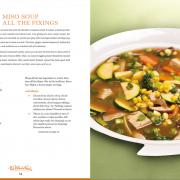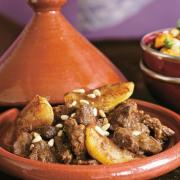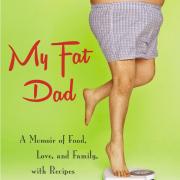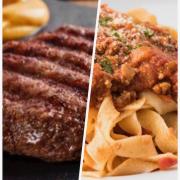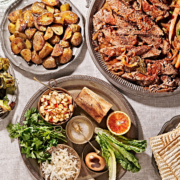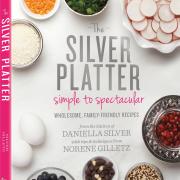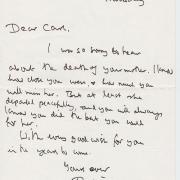Review of my Cookbook by Tara Barker
Thank you so much Tara Barker for your glowing review of my Latest Cookbook!
Cookbooks these days have become works of art. We display them on our coffee tables, give them our coveted, valuable kitchen counter space, we read them in bed as if they were gripping novels. Their pages are glossy, the recipes are illustrated by full-page color photographs, and we all try not to allow them to appear used. No dog-eared pages, no splatters of oil or smears of chocolate, no notes in the margins.
No one wants to deface a work of art.
I’ve got to say, I find this whole glamorization bit somewhat irritating, and definitely stifling. When the book comes with an unspoken Wrinkle Not, Smudge Not code of use, it’s hard to believe that the recipes inside are for approachable, real, attainable foods. And suddenly, in browsing through these immaculate tomes, the joy of cooking becomes someone else’s joy, someone with elite training and a gourmet pantry and infinite patience and a lackey to clean up afterwards.
We can ogle the images, we can imagine how amazing all the dishes must taste, we can wish we lived closer to the chef’s restaurant so that we could try them out for ourselves, but it takes an intrepid soul to push past the fantasy presented in those pages and get into their own poorly laid-out, messy, lived-in kitchen to try to cook the food for themselves.
Rather than empowering, such books can actually be quite intimidating.
But great food — and the making of it — should be accessible to anyone who wants it. Instead of scaring you away from your own kitchen, hinting that maybe you are inadequate, a good cookbook should have you preheating the oven and pulling mixing bowls off the shelf before you’ve even looked to see what the last chapter is about. The book should loose its pristine quality as quickly as possible, as you mark recipes you’re inspired by and drip egg white across the pages and get flour stuck in the binding. The book should make you excited to cook.
All this is not to say I don’t appreciate beautiful cookbooks. I do. I love beautiful things, and art, and glamor. And I have my share of trophy books, ones with the dust jackets still in place and spines still uncracked. But those ones don’t inspire me to actually make food. They inspire me to dream about other people’s luxurious, exotic lives. All very well and good on a lazy Sunday morning, but not very useful when actual food is expected of me.
This is as odd way to begin a cookbook review. As if I am either going to tell you the book is too beautiful to be functional, or that it is functional, and thus not exactly eye candy.
It’s neither, actually.
I was recently sent a review copy of Lévana Kirschenbaum’s new cookbook, The Whole Foods Kosher Kitchen. Now, I’m not kosher, nor do I have any close friends or family who keep kosher, but the ‘whole foods’ aspect was a definite draw for me. That and also the fact that the publisher touted the extensive number of gluten-free dishes in the book. And if I’m being completely honest, I should mention that the idea of committing myself to cooking out of a book I might never have looked twice at appealed to me, in a dorky, homework-loving sort of way.
Here’s why I might not have given this book a second look if I came across it at a bookstore: it’s not a coffee table cookbook. It’s not written by a well-known celebrity chef. There are far more recipes than photos. It’s softcover. It’s not an ugly book, but neither is it a gorgeous cookbook by today’s standards. And as horrible and hypocritical it is of me to say so, it’s hard these days to get interested in a book like that, when you’re being wooed by the fancy-schmancy famous books on the top shelf.
This is too bad, and I have learned my lesson. Because every recipe I tried in this book was wonderful. I will be making them again, along with all the other dishes I haven’t had time to try, but which sound delicious. Ms. Kirschenbaum has crafted a cookbook that celebrates healthy eating with recipes that will appeal to a wide range of cooks. Not only is the entire book kosher, but much of it is also gluten-free, dairy-free, or vegan, and helpful tips for variations and substitutions abound. The entire first chapter is devoted to laying out all the benefits of eating whole, unprocessed foods that one makes from scratch. And yet, none of the book feels preachy. Out of all the tools used to encourage a healthy lifestyle, guilt never makes an appearance. Ms. Kirschenbaum’s tone throughout is enthusiastic, positive, and infectious. Reading her prose and recipes makes it clear that one of the easiest ways to embrace life and honor our bodies is through food.Real food. Whole grains. Legumes. Fresh produce. Heart-healthy fats. Natural sweeteners.
This is not to say that all the recipes are “hippy” health food. Yes, tofu makes many appearances. And there are lots of nuts and seeds, leafy vegetables, and exotic spices. But thankfully, modern cuisine has moved past the tofu stir-fries and lentil burgers that once typified “health food.” Now, you can choose from Tilapia Fillets with Miso Sauce and Shiitake Mushrooms, Moroccan Turkey Patties in Lemon Sauce, or Arborio Risotto with Spinach and Asparagus. Need more meat? How about the classic Boeuf Bourguignon or some Chinese Meat Loaf? Looking for dessert? You’ve got a myriad of choices, ranging from Ricotta Almond Pie to Lemon Coconut Mousse to Chocolate Jasmine Marble Cake. Seriously, people. These decadent, tantalizing foods are good for you! I sort of feel like I’ve discovered a culinary secret; a trove of alluring recipes hidden inside such an unassuming book.
We ate the White Bean Salad with Artichokes and Swiss Chard at my niece’s 4th birthday party, and I was amazed at how well all the elements melded together. The rich, earthiness of the chard and beans, the brightness of the lemon, and the rosemary under it all, providing an elusive flavor that no one could pin down, but everyone loved. It’s my new favorite go-to dish for potlucks.
I made the Pasta with Broccoli and Salmon for a weeknight dinner for the me and the boys. Pasta is part of the regular rotation around here. Adding broccoli and salmon to it is not unheard of. But making a roux-based milk sauce which the salmon is cooked in and ground broccoli is stirred into? That’s a whole other way of cooking dinner for me, and suddenly old, boring ingredients seemed new again. (Although maybe not visually appealing. That was an odd dish for me to try to photograph. Forgive me, and know that it really did taste wonderful!)
That “old-standbys-turned-new” phenomenon happened again when I made the Chocolate Almond Date Smoothie. I make smoothies a lot, and I eat chocolate and almonds a lot. But I never combine them to make a healthy meal-in-a-glass. Soaking the raw almonds in boiling water allowed even my wimpy blender to easily grind them up. They didn’t completely purée however, which gave my smoothie a coarse texture I rather liked. Somehow I feel that if it’s going to be an acceptable meal substitute, you shouldn’t be able to chug it in one giant gulp. A friend sampled the smoothie and loved it, remarking that it reminded her of something she’d had before, that she couldn’t put her finger on. I felt the same way. Maybe there’s a chocolate-almond-date bar out there that I ate years ago with this same flavor?
When I was told that this cookbook had a lot of gluten-free options in it, I just sort of assumed that meant a lot of naturally gluten-free dishes. (It is all about whole foods, after all. Most of which are naturally gluten-free.) So I was pretty amazed — and skeptical — to find a recipe for Gluten-Free Bread! Of course I had to make it. And I was all prepared to be super-critical and not like it nearly as much as the breads that more established gluten-free bakers have been creating lately. Well, that bread humbled me. It was really good. I attribute this partly to the freedom given to the reader to create a bread they will like; the recipe simply calls for “3 cups gluten-free flour,” with some suggestions of gluten-free flours in parenthesis. Knowing my current grain preferences, I used a combination of light buckwheat, gluten-free oat, teff, and brown rice flours. But it’s not just the flour combination that made this bread good. It’s a truly solid recipe. I made half the batch into rolls and, taking Ms. Kirschenbaum’s suggestion, made the rest into a pizza crust, which I turned into a breakfast pizza for a Summer Solstice walk and picnic I took the kids on. We loved it. And I am learning to trust that good gluten-free baking can be found in unexpected places.
Finally, I made pie. Chocolate Peanut Butter Pie, to be exact. And while that sounds good, my motivation for making it was based on something else entirely: the recipe called for silken tofu.
Years ago, my mom regularly made a tofu chocolate pudding, which sometimes got poured into a pie crust to make tofu chocolate cream pie. Only it wasn’t a chocolate pudding/pie, but carob. This was back in her hippie-macrobiotic days, and I loved it. It tasted like, predictably, carob and tofu, mildly sweetened with honey. I know I’m at risk of loosing my culinary credibility here by admitting to my youthful preferences, but I can’t apologize or make excuses for my childhood taste buds. So anyway, I was curious to see if I still loved the tofu-carob/cocoa combination as much as I remembered.
Thing is, Ms. Kirschenbaum’s pie calls for chocolate chips and cocoa powder, plus peanut butter and cream cheese and white sugar and coffee and brandy. Um, yeah. A far cry from the puritanical ingredients in Mom’s pie. Obviously, it was awesome. And bore no resemblance to the tofu pies of my childhood, which in retrospect I think is a good thing. To my surprise, I didn’t even notice or care that the graham cracker crust (I used these) was held together with vegetable oil, instead of the melted butter that would have been my default choice. It was just an insanely rich, fudgy pie that, despite my making a half batch and dividing it into two mini pies in an attempt at portion control, I managed to devour in a ridiculously short period of time. Woe is the family that lives with me and doesn’t learn to claim their share of desserts before I get to them!
So, after all this (I can’t believe you read this far!), I suppose the question is, do I recommend the book? And the answer is definitely yes. Oh sure, I had some issues with it, such as some of the vague units of measurement (a large bunch? a good pinch?), and the fact that, despite offering lots of ways to make an item dairy- or gluten-free if necessary, when a recipe specifically calls for a dairy-free version of a normally dairy-full ingredient, there is no acknowledgement that you can use the original dairy version in its place. (For the record, I used regular cream cheese in the chocolate pie, and regular milk powder in the gluten-free bread, both with no ill effects. So apparently the substitutions work both ways.) But taken as a whole, the book is full of inventive, tempting recipes that you can feel good about eating. And better still, it’s approachable, down to earth, and inviting.
This cookbook might actually be one that begins to look lived in, as only the best, most cherished possessions do.
Tara Barker

